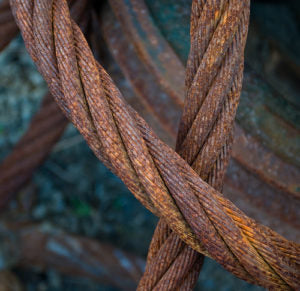Corrosive Environments and Factors

Corrosion is the enemy of tools and equipment, which is why selecting the proper materials and equipment for your working environment is vital to prevent rust and other forms of corrosion. For example, the Lug-All Marine Grade Ratchet Winch Hoist is made with an anodized aluminum alloy frame that repels hazardous rust from sea salt. It’s important to take proper precaution with your work equipment, so operators and workers must be able to determine where corrosion will occur and what precautions should be taken for prevention.
Coastal and Marine Environments
Coastal and marine environments are corrosive to metals because of the quantity of sodium chloride (salt) found in the water. The salt from the sea water will travel through coastal winds, mist, fog, and sea-spray up to five miles from the coastline. Hoists and other equipment should be kept at considerable distances from the ocean if they are not manufactured with protective materials. Below are questions to help determine if a location is considered a marine environment:
- Is the work within five miles of a large body of salt water?
- Is the ocean visible from the roof of a nearby building?
- Is there visible corrosion on exterior structures, HVAC equipment, or other equipment made from similar metals?
If the answer is “yes” to any of the above questions, then measures should be taken to resist corrosion, such as using marine grade materials to protect from saltwater corrosion. In the end, marine grade materials reduce the risk of malfunction due to rust and the cost of replacements.
Variables of Corrosion in Coastal and Marine Environments
Although there are many variables, the primary variables of corrosion rates near the coast are:
- the amount of salt in the air.
- the time of wetness of the metal surface.
- the temperature.
- the level of other atmospheric pollutants.
The variables above are heavily influenced by environmental factors, such as distance from the ocean, elevation, wind direction, wave action, rainfall, humidity, the degree of shelter, and the level of industrial air pollution. For these reasons, corrosion rates vary greatly from place to place and even during different times of the day at the same location.
Industrial Corrosion
Although coastal and marine environments are often associated with corrosion, marine environments aren’t the only environments conducive for accelerated corrosion. In highly industrial environments, contaminants in the air can contribute to corrosion. Emissions that come from factories, vehicles, or power plants can potentially weaken your equipment. Gases like sulfur and nitrogen oxide that are emitted into the atmosphere in industrial locations return in forms of condensation, such as acidic dew or acid rain.
Industrial emissions aren’t the only industrial concern. Industrial dust particles can be contaminated with harmful metal oxides, chlorides, sulfates, sulfuric acid, carbon, and carbon compounds. These particles when combined with oxygen, water, or high humidity environments can be highly corrosive.
Rural Locations
Rural environments can be a breeding ground for corrosion as well, especially farm environments. The nitrates from fertilizer can cause corrosion to tools and equipment. Additionally, ammonia and nitrogen found in high levels of animal waste and diesel fuel contribute to accelerated corrosion if not properly maintained.
Prevention and Protection from Corrosion
A common corrosion prevention and protection method is galvanizing steel with a layer of zinc. In marine environments, tests show that zinc corrodes about 20 times slower than common steel alloys. The thicker the galvanized coating, the longer the metal will resist corrosion. Another possible solution is use of 304 or 316 stainless steel. Although 304 stainless steel is considered adequate for most marine environments, 316 stainless steel corrodes slower, making it a better option than 304 stainless steel. After 40 years of oceanfront exposure, 304 and 316 stainless steel samples used in 1940’s experiments had no rusting or loss of strength. The only problem with 304 and 316 stainless steel is that it is significantly more expensive than other corrosion prevention methods. Although corrosion prevention and protection methods cost more initially, that initial cost is offset by lower maintenance and replacement fees.
Regardless of which environment you’re working in, if tools and equipment aren’t properly protected and maintained, you put your tools and equipment at risk, not to mention your workers using the potentially defective equipment. The functionality and safety of equipment is reliant on your ability to understand the factors in which you can control. To ensure the protection of your tools and workers, adhere to the following:
- Purchase tools and materials that are manufactured for environmental elements.
- Perform routine inspections.
- Perform adequate cleaning to remove residue after use.
- Properly store equipment to avoid exposure to corrosive elements after use.
Corrosion of products is inevitable, but corrosion can be reduced by understanding the main causes of corrosion, performing preventative maintenance, and spending extra money for more corrosion resistant materials.
Sources:
